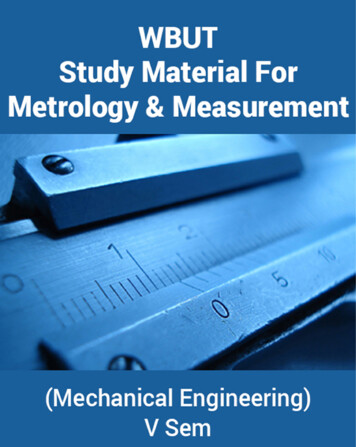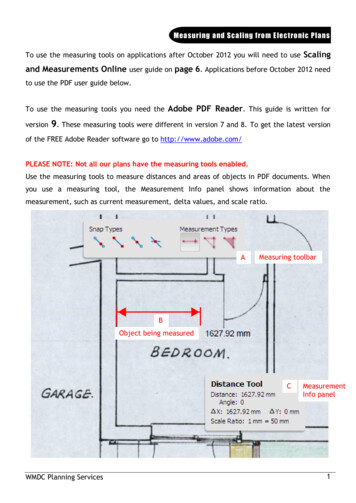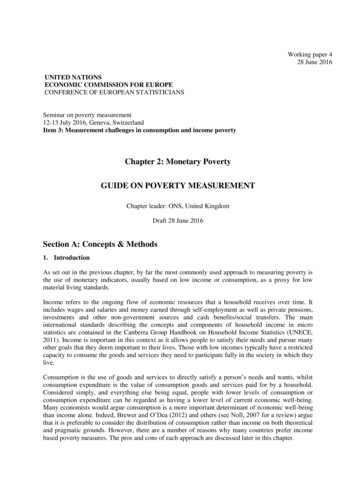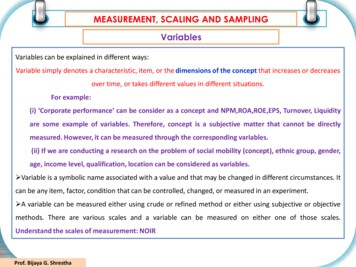
Transcription
mywbut.comChapter 1: STANDARDS OF MEASUREMENTDefinition of Metrology: Metrology (from Ancient Greek metron (measure) and logos(study of)) is the science of measurement. Metrology includes all theoretical and practicalaspects of measurement.Metrology is concerned with the establishment, reproduction, conservation and transferof units of measurement & their standards.For engineering purposes, metrology is restricted to measurements of length and angle &quantities which are expressed in linear or angular terms.Measurement is a process of comparing quantitatively an unknown magnitude with apredefined standard.Objectives of Metrology: The basic objectives of metrology are;1. To provide accuracy at minimum cost.2. Thorough evaluation of newly developed products, and to ensure that componentsare within the specified dimensions.3. To determine the process capabilities.4. To assess the measuring instrument capabilities and ensure that they are adequate fortheir specific measurements.5. To reduce the cost of inspection & rejections and rework.6. To standardize measuring methods.7. To maintain the accuracy of measurements through periodical calibration of theinstruments.8. To prepare designs for gauges and special inspection fixtures.Definition of Standards:A standard is defined as “something that is set up and established by an authority as ruleof the measure of quantity, weight, extent, value or quality”.For example, a meter is a standard established by an international organization formeasurement of length. Industry, commerce, international trade in modern civilizationwould be impossible without a good system of standards.Role of Standards: The role of standards is to achieve uniform, consistent and repeatablemeasurements throughout the world. Today our entire industrial economy is based onthe interchangeability of parts the method of manufacture. To achieve this, a measuringsystem adequate to define the features to the accuracy required & the standards ofsufficient accuracy to support the measuring system are necessary.
mywbut.comSTANDARDS OF LENGTHIn practice, the accurate measurement must be made by comparison with a standard ofknown dimension and such a standard is called “Primary Standard”The first accurate standard was made in England and was known as “Imperial Standardyard” which was followed by International Prototype meter” made in France. Sincethese two standards of length were made of metal alloys they are called ‘material lengthstandards’.International Prototype meter:It is defined as the straight line distance, at 0oC, between the engraved lines of pureplatinum-iridium alloy (90% platinum & 10% iridium) of 1020 mm total length andhaving a ‘tresca’ cross section as shown in fig. The graduations are on the upper surfaceof the web which coincides with the neutral axis of the section.Engravedlines16 mmEngravedlinesNeutral axisWebPlatinum-iridium alloy1 meter(at 0deg C)1020 mm16 mmHistorical International Prototype Meter bar, made of an alloy of platinum and iridium,that was the standard from 1889 to 1960.
mywbut.comThe tresca cross section gives greater rigidity for the amount of material involved and istherefore economic in the use of an expensive metal. The platinum-iridium alloy is usedbecause it is non oxidizable and retains good polished surface required for engravinggood quality lines.Imperial Standard yard:An imperial standard yard, shown in fig, is a bronze (82% Cu, 13% tin, 5% Zinc) bar of1 inch square section and 38 inches long. A round recess, 1 inch away from the two endsis cut at both ends upto the central or ‘neutral plane’ of the bar.Further, a small round recess of (1/10) inch in diameter is made below the center. Twogold plugs of (1/10) inch diameter having engravings are inserted into these holes so thatthe lines (engravings) are in neutral plane.38"36" at 62 deg FNeutral axis1"1"Gold plugBronze bar 82% Cu, 13% Tin, 5% Zinc1"Enlarged view of gold plug showing engravingYard is defined as the distance between the two central transverse lines of the gold plugat 620F.The purpose of keeping the gold plugs in line with the neutral axis is to ensure thatthe neutral axis remains unaffected due to bending, and to protect the gold plugs fromaccidental damage.
mywbut.comBronze Yard was the official standard of length for the United States between 1855 and1892, when the US went to metric standards. 1 yard 0.9144 meter. The yard is used asthe standard unit of field-length measurement in American, Canadian and Associationfootball, cricket pitch dimensions, swimming pools, and in some countries, golf fairwaymeasurements.Disadvantages of Material length standards:1. Material length standards vary in length over the years owing to molecular changesin the alloy.2. The exact replicas of material length standards were not available for usesomewhere else.3. If these standards are accidentally damaged or destroyed then exact copies couldnot be made.4. Conversion factors have to be used for changing over to metric system.Light (Optical) wave Length Standard:Because of the problems of variation in length of material length standards, thepossibility of using light as a basic unit to define primary standard has been considered.The wavelength of a selected radiation of light and is used as the basic unit of length.Since the wavelength is not a physical one, it need not be preserved & can be easilyreproducible without considerable error.A krypton-filled discharge tube in the shape of the element's atomic symbol. A colorless,odorless, tasteless noble gas, krypton occurs in trace amounts in the atmosphere, isisolated by fractionally distilling liquefied air. The high power and relative ease ofoperation of krypton discharge tubes caused (from 1960 to 1983) the official meter to bedefined in terms of one orange-red spectral line of krypton-86.
mywbut.comMeter as on Today: In 1983, the 17th general conference on weights & measuresproposed the use of speed of light as a technically feasible & practicable definition ofmeter.Meter is now defined as the length of path of travelled by light in vacuum in (1/299792458) second. The light used is iodine stabilized helium-neon laser.Advantages of using wave length standards:1.2.3.4.Length does not change.It can be easily reproduced easily if destroyed.This primary unit is easily accessible to any physical laboratories.It can be used for making measurements with much higher accuracy than materialstandards.5. Wavelength standard can be reproduced consistently at any time and at any place.Subdivision of standards:The imperial standard yard and the international prototype meter are master standards& cannot be used for ordinary purposes. Thus based upon the accuracy required, thestandards are subdivided into four grades namely;1. Primary Standards2. Secondary standards3. Teritiary standards4. Working standardsPrimary standards:They are material standard preserved under most careful conditions.These are not used for directly for measurements but are used once in 10 or 20 years forcalibrating secondary standards.Ex:International Prototype meter, Imperial Standard yard.Secondary standards:These are close copies of primary standards w.r.t design, material & length. Any errorexisting in these standards is recorded by comparison with primary standards after longintervals. They are kept at a number of places under great supervision and serve asreference for tertiary standards. This also acts as safeguard against the loss or destructionof primary standards.
mywbut.comTeritiary standards:The primary or secondary standards exist as the ultimate controls for reference at rareintervals.Tertiary standards are the reference standards employed by National Physical laboratory(N.P.L) and are the first standards to be used for reference in laboratories & workshops.They are made as close copies of secondary standards & are kept as reference forcomparison with working standards.Working standards:These standards are similar in design to primary, secondary & tertiary standards.But being less in cost and are made of low grade materials, they are used for generalapplications in metrology laboratories.Sometimes, standards are also classified as; Reference standards (used as reference purposes) Calibration standards (used for calibration of inspection & working standards) Inspection standards (used by inspectors) Working standards (used by operators)LINE STANDARDSWhen the length being measured is expressed as the distance between two lines, then it iscalled “Line Standard”.Examples: Measuring scales, Imperial standard yard, International prototype meter, etc.Characteristics of Line Standards:1. Scales can be accurately engraved but it is difficult to take the full advantage of thisaccuracy. Ex: A steel rule can be read to about 0.2 mm of true dimension.2. A scale is quick and easy to use over a wide range of measurements.3. The wear on the leading ends results in ‘under sizing’4. A scale does not possess a ‘built in’ datum which would allow easy scale alignmentwith the axis of measurement, this again results in ‘under sizing’.5. Scales are subjected to parallax effect, which is a source of both positive & negativereading errors’6. Scales are not convenient for close tolerance length measurements except inconjunction with microscopes.
mywbut.comEND STANDARDSWhen the length being measured is expressed as the distance between two parallel faces,then it is called ‘End standard’.End standards can be made to a very high degree of accuracy.Ex: Slip gauges, Gap gauges, Ends of micrometer anvils, etc.Characteristics of End Standards:1. End standards are highly accurate and are well suited for measurements of closetolerances as small as 0.0005 mm.2. They are time consuming in use and prove only one dimension at a time.3. End standards are subjected to wear on their measuring faces.4. End standards have a ‘built in’ datum, because their measuring faces are flat ¶llel and can be positively located on a datum surface.5. They are not subjected to the parallax effect since their use depends on “feel”.6. Groups of blocks may be “wrung” together to build up any length. But faultywringing leads to damage.7. The accuracy of both end & line standards are affected by temperature change.TRANSFER FROM LINE STANDARD TO END STANDARD(NPL method of deriving End standard from line standard)Line Standard Comparator:x1Measureddifferenced1 x1- x2x236 inch linestandard1/2inch block/2 inch block1135 /2 inch end standardablcd
mywbut.comA line standard comparator is used to transfer the line standard correctly to the ends of abar.It consists of two microscopes mounted about a yard apart over a table. An end standardabout 351/2 inch in length is produced with flat & parallel faces. Two 1/2 inch blockswith centrally engraved lines are ‘wrung’ to the ends of this end standard, such that thedistance between the center lines is approximately 36 inches.The difference of readings between the lines on the line standard & the lines on the endstandard are noted every time, by arranging the end blocks in different ways to eliminateerrors in wringing & of marking of center lines.If the actual length of the end standard is l, then for the four different ways of wringingthe end blocks, we can write;l b c 36 d1l b d 36 d2l a c 36 d3l a d 36 d4Where d1, d2, d3 & d4 are the differences noted for the successive positions of the 1/2 inchblocks respectively()2la6 cd Taking mean,Next the 351/2 inch end standard wrung with one of the 1/2 inch blocks is compared with36 inch end bar (to be calibrated) on a Brooke’s level comparator & the deviation D1 maybe noted.D1Lba
mywbut.comThen the other 1/2 inch block is wrung with it & again is compared with the end bar (tobe calibrated) & the deviation D2 is noted. If L is the actual length of the 36 inch end bar,then;l a b L D1,l c d L D2() Combining the above equations, CALIBRATION OF END BARSThe actual lengths of end bars can be found by wringing them together and comparingthem with a calibrated standard using a level comparator and also individually comparingamong themselves. This helps to set up a system of linear equations which can be solvedto find the actual lengths of individual bars.The procedure is clearly explained in the forthcoming numerical problems.Numerical problem-1:Three 100 mm end bars are measured on a level comparator by first wringing themtogether and comparing with a calibrated 300 mm bar which has a known error of 40µm. The three end bars together measure 64 µm less than the 300 µm bar. Bar A is18 µm longer than bar B and 23 µm longer than bar C. Find the actual length of eachbar.300 mm 40 µm64 µmCBarB18 µm23 µmALAALBBLCC
mywbut.comµ()(µµµA()BLC((LmmmLLmLom1 ()()99.9899.983. Eqn4g06q)6(3),(2),.mmg,)mmm18)0.00.023( 3()2(, (2))0.023(1)(3), 3(3001 )300.Numerical problem-2:Four end bars of basic length 100 mm are to be calibrated using a standard bar of 400mm whose actual length is 399.9992 mm. It was also found that lengths of bars B,C &D in comparison with A are 0.0002 mm, 0.0004 mm and -0.0001 mm respectivelyand the length of all the four bars put together in comparison with the standard bar is 0.0003 mm longer. Determine the actual lengths of each end bars.
0arly. 99)(qn97570.0mm0412(gmmg,01002),mmqns00)(( 0002)()0001)399.9995), 3(3) &9( 5) in(1)EqnSLIP GAUGES OR GAUGE BLOCKS(JOHANSSON GAUGES)Slip gauges are rectangular blocks of steel having cross section of 30 mm face length &10 mm face width as shown in fig.Measuring faceSlip gaugelength lFace lengthhidtewcaF
mywbut.comSlip gauges are blocks of steel that have been hardened and stabilized by heat treatment.They are ground and lapped to size to very high standards of accuracy and surface finish.A gauge block (also known Johansson gauge, slip gauge, or Jo block) is a precisionlength measuring standard consisting of a ground and lapped metal or ceramic block. Slipgauges were invented in 1896 by Swedish machinist Carl Edward Johansson.Manufacture of Slip Gauges:JEDGCGBE FAJC DFA B
mywbut.comWhen correctly cleaned and wrung together, the individual slip gauges adhere to eachother by molecular attraction and, if left like this for too long, a partial cold weld willtake place.If this is allowed to occur, the gauging surface will be irreparable after use, hence thegauges should be separated carefully by sliding them apart. They should then be cleaned,smeared with petroleum jelly (Vaseline) and returned to their case.Protector Slips:In addition, some sets also contain protector slips that are 2.50mm thick and are madefrom a hard, wear resistant material such as tungsten carbide. These are added to the endsof the slip gauge stack to protect the other gauge blocks from wear. Allowance must bemade of the thickness of the protector slips when they are used.Wringing of Slip Gauges:Slip gauges are wrung together to give a stack of the required dimension. In order toachieve the maximum accuracy the following precautions must be taken. Use the minimum number of blocks. Wipe the measuring faces clean using soft clean chamois leather. Wring the individual blocks together by first pressing at right angles, sliding & thentwisting.Wringing of Slip Gauges
mywbut.com36 Johansson gauge blocks wrung together easily support their own weightINDIAN STANDARD ON SLIP GAUGES (IS 2984-1966)Slip gauges are graded according to their accuracy as Grade 0, Grade I & Grade II.Grade II is intended for use in workshops during actual production of components, tools& gauges.Grade I is of higher accuracy for use in inspection departments.Grade 0 is used in laboratories and standard rooms for periodic calibration of Grade I &Grade II gauges.M-87 set of slip gauges:
WBUT Study Material For MetrologyAnd Measurement (MechanicalEngineering) V Sem50%OFFPublisher : Faculty NotesAuthor : Panel Of ExpertsType the URL : http://www.kopykitab.com/product/10162Get this eBook
Definition of Metrology: Metrology (from Ancient Greek metron (measure) and logos (study of)) is the science of measurement. Metrology includes all theoretical and practical aspects of measurement. Metrology is concerned with the establishment, reproduction, conservation and transfer of units of measurement & their standards.










